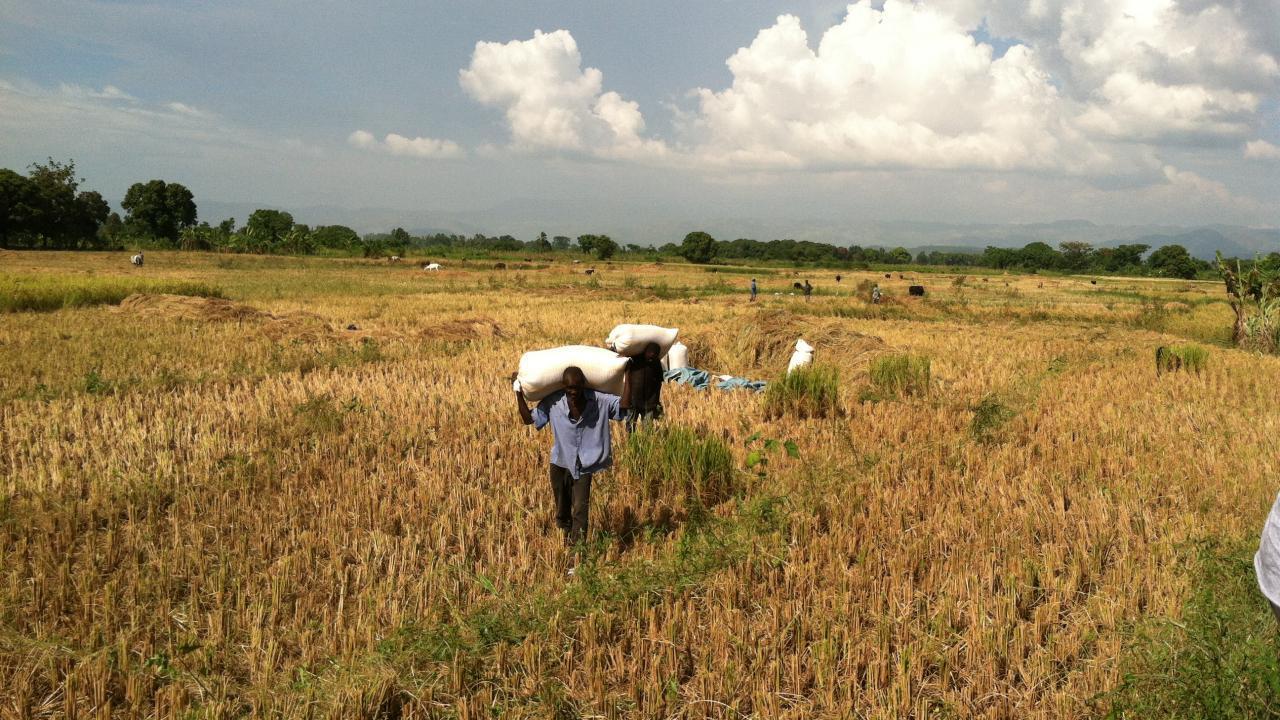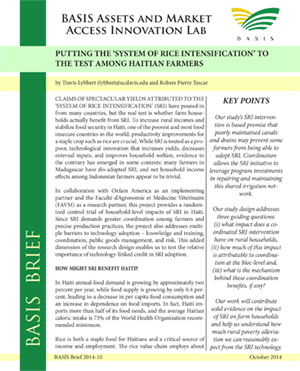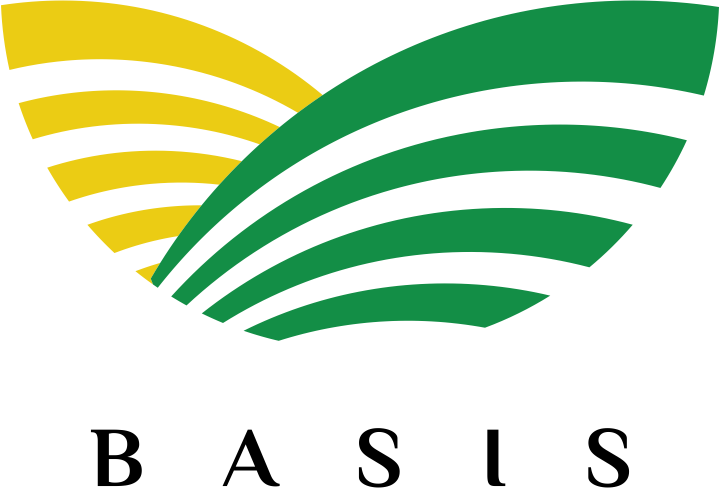
Claims of spectacular yields attributed to the System of Rice Intensification (SRI) have poured in from many countries, but the real test is whether farm households actually benefit from SRI. To increase rural incomes and stabilize food security in Haiti, one of the poorest and most food insecure countries in the world, productivity improvements for a staple crop such as rice are crucial.
Key Points
- Our study’s SRI intervention is based premise that poorly maintained canals and drains may prevent some farmers from being able to adopt SRI. Coordination allows the SRI initiative to leverage program investments in repairing and maintaining this shared irrigation network.
- Our study design addresses three guiding questions: (i) what impact does a coordinated SRI intervention have on rural households, (ii) how much of this impact is attributable to coordination at the bloc-level and, (iii) what is the mechanism behind these coordination benefits, if any?
- Our work will contribute solid evidence on the impact of SRI on farm households and help us understand how much rural poverty alleviation we can reasonably expect from the SRI technology.
 While SRI is touted as a propoor, technological innovation that increases yields, decreases external inputs, and improves household welfare, evidence to the contrary has emerged in some contexts: many farmers in Madagascar have dis-adopted SRI, and net household income effects among Indonesian farmers appear to be trivial.
While SRI is touted as a propoor, technological innovation that increases yields, decreases external inputs, and improves household welfare, evidence to the contrary has emerged in some contexts: many farmers in Madagascar have dis-adopted SRI, and net household income effects among Indonesian farmers appear to be trivial.
In collaboration with Oxfam America as an implementing partner and the Faculté d’Agronomie et Médecine Vétérinaire (FAVM) as a research partner, this project provides a randomized control trial of household-level impacts of SRI in Haiti. Since SRI demands greater coordination among farmers and precise production practices, the project also addresses multiple barriers to technology adoption – knowledge and training, coordination, public goods management, and risk. This added dimension of the research design enables us to test the relative importance of technology-linked credit in SRI adoption.
How Might SRI Benefit Haiti?
In Haiti annual food demand is growing by approximately two percent per year, while food supply is growing by only 0.4 percent, leading to a decrease in per capita food consumption and an increase in dependence on food imports. In fact, Haiti imports more than half of its food needs, and the average Haitian caloric intake is 73% of the World Health Organization recommended minimum.
Rice is both a staple food for Haitians and a critical source of income and employment. The rice value chain employs about 5% of the total population, and if family members are factored in, roughly a million people are directly affected by the rice sector’s productivity and profitability. National rice production has been stagnant for the past 40 years. While local rice production once met all consumption needs, it now accounts for less than 20% of consumption.
Thus, the potential spillover effects from increasing and improving rice production are large. In fact, the Haitian Ministry of Agriculture has pinpointed rice as a critical avenue for increasing rural incomes and stabilizing national food security. The plan calls for developing the rice value chain, increasing productivity, and modernizing rice production backed by the more than $770 million it has budgeted for agricultural reconstruction.
Given these circumstances widespread adoption of SRI has the potential to play a crucial role in changing the status quo in Haiti. The SRI cultivation method emerged in Madagascar in the 1980s as a set of management practices that promotes quick and healthy plant establishment by reducing planting density, improving soil conditions with organic matter, and reducing and controlling irrigation.
New seed varieties and external inputs are not required; in fact, SRI uses lower levels of seeds, fertilizers, and water. However, careful placement of transplants and frequent weeding, especially when plants are young, increase SRI labor requirements compared to traditional methods. SRI also requires precise water control, which often causes management problems when farmers share a canal irrigation system.
Does SRI Increase Incomes and Stabilize Food Security?
To explore if a coordinated SRI intervention has an impact on rural households we will measure changes to both household income and food security in the Artibonite Valley, which produces between 75% and 80% of the country’s rice. This region also contains the country’s largest river and an extensive irrigation system. A 2011- 2012 Oxfam America pilot in the valley showed that SRI increased yield per hectare by 67% and rice profit per hectare by 132%. While these results are impressive, first, it is unclear how inputs, in particular labor, were valued in this study. Thus, more careful economic analysis is necessary to determine the profitability of SRI compared to traditional rice production methods.
A 2011-2012 Oxfam America pilot in the valley showed that SRI increased yield per hectare by 67% and rice profit per hectare by 132%. While these results are impressive, first, it is unclear how inputs, in particular labor, were valued in this study. Thus, more careful economic analysis is necessary to determine the profitability of SRI compared to traditional rice production methods.
Second, while rice profit clearly increased, households may have made adjustments by reallocating labor and/or eliminating other economic enterprises in order to accommodate the increased labor needed for SRI. In the field trials, labor requirements for preparation and maintenance were 55% and 39% higher, respectively, for SRI. Thus to understand the household welfare impacts of SRI in Haiti, we need to understand local labor markets, how adopting households reallocate labor and how intensifying labor investments in rice affects overall household outcomes such as total income and food security.
Program Implementation
We chose to work with Oxfam America’s Artibonite Valley Livelihoods Program. This program works with rice farmers to improve livelihoods and decrease vulnerability to shocks through improvements in rice production, processing, and marketing in the national rice value chain and through improved local, national, and international policies and practices.
Based on lessons learned in the first few years of its program, Oxfam America recently formulated an ambitious coordinated SRI intervention that targets entire irrigation blocs, a network of shared canals and drains, with incentives for full SRI adoption. The Ministry of Agriculture has also organized all farmers with plots in an identified collection of blocs into Water Users Associations in order to facilitate coordination.
Our study’s SRI intervention is based on the same premise— poorly maintained canals and drains may prevent some farmers from being able to adopt SRI. Coordinating at the bloc level allows the initiative to leverage program investments in repairing and maintaining this shared irrigation network. Other benefits of coordination may arise from synchronized flooding cycles and production phrases, agronomic monitoring, and social learning within the bloc.
Building on Oxfam America’s program our intervention will also include SRI training, input credit provision, and organizational support for canal draining. From March to September 2014 Oxfam trained farmers in SRI, put in place both a technical assistance and follow-up program for farmers in treatment blocs, and provided insured credit to farmers in treatment blocs and standard credit to farmers in control blocs.
Study Design
To begin considering if any changes in household income or food security can be attributed to either poor (or excellent) irrigation coordination we mapped the selected study area, consisting of two control blocs and two treatment blocs, to identify each plot and farmer with the plot’s location relative to irrigation canals and drains and estimate total plot land area. Farmers’ landholdings were used to determine their credit limit. Plot location is important for answering questions about whether or not adoption rates and SRI success depends on proximity to canals and drains and if SRI adoption spreads to neighboring plots.
Since coordination among farmers and the water control it provides is a prerequisite for SRI adoption for many farmers, the SRI ‘treatment’ in treatment blocs is bundled with water control coordination. Although it does not constitute a separate arm of the research design, we hope to learn something about how coordination affects individual adoption decisions, learning and adjustment, and SRI’s agronomic potential for plots in different locations relative to canals and drains.
To better understand and measure cooperative behavior and the coordinated use of public goods, in April 2014 we ran public goods experiments among groups of neighboring farmers from the four study blocs. Experiments were conducted with 240 farmers, all in groups with other farmers who farm adjacent plots. These public goods experiments give us a baseline measure of the degree of cooperation (e.g., canal maintenance) for farmers of neighboring plots. Combined with subsequent experiments, we will be able to test whether coordination among small groups of farmers affects adoption and whether exposure to SRI changes baseline coordination among farmers.
Our study design addresses three guiding questions: (i) what impact does a coordinated SRI intervention have on rural households, (ii) how much of this impact is attributable to coordination at the bloc-level and, (iii) what is the mechanism behind these coordination benefits, if any? The design relies on random assignment of blocs to SRI treatment and control groups. While farmers in all the blocs have access to service credit to finance plot preparation and input purchases, the research design also introduces a credit subsidy randomized at the a farmer-level.
Coordinated SRI Blocks
This treatment began in Spring 2014. Households with plots in these blocs received (1) SRI training before planting and continued monitoring and training throughout the growing season and (2) bloc-level coordination and investment in the irrigation network of canals and drains.
Control blocs
Households with only plots in control blocs will continue to have access to credit for agricultural inputs and plot preparation, but will receive neither (1) nor (2) in the initial two years of the intervention.
Subsidized and ‘technology-linked’ credit
In collaboration with our local partners and with a local financial institution, we designed an agricultural credit product specifically linked to the input costs associated with SRI adoption. Farmers in the SRI treatment blocs were offered this SRI-linked credit, which has a credit limit per acre under cultivation that is calibrated using field trial data collected by FAMV. Farmers in the control blocs were offered a standard credit product with a lower credit limit, reflecting the slightly lower input costs associated with traditional rice production. Farmers in both SRI treatment and control blocs were randomly selected to receive a subsidized interest rate (half the rate charged on the unsubsidized loans). This credit subsidy provides an added incentive to adopt SRI, which creates exogenous variation in SRI adoption to help estimate household-level SRI benefits.
Anticipated Impacts
Through collaboration with FAMV, Oxfam, and local farmers’ associations, we have an opportunity to influence future agricultural development policies and research in Haiti. This project will inform roll-out of larger scale agricultural development projects and build our partner’s research and extension capacities. Several organizations, including both USAID and Oxfam, are planning to scale up SRI interventions in Haiti in the coming years. Elsewhere in the developing world, hopes are similarly high for massive yield and income gains due to SRI adoption. Our results will aid in the development of these programs, support policy work, and provide intervention strategies.
Oxfam and its partners will continue promoting SRI through the Artibonite Valley Livelihoods Program after this project concludes in 2016. Findings from this study will provide insight into how targeted farmers benefit from an intervention program and if a similar intervention could be scaled up to the entire Artibonite Valley or even throughout the country. The lessons learned and experience gained will also be used to guide future activities and leverage the resources and experience of other development organizations, the government, and private businesses.
Finally, because our research design aims to clarify why and how SRI impacts household income, food security and adoption, these results may have relevance beyond the Haitian context. For example, Oxfam America has SRI initiatives worldwide and is eager to learn how to modify these programs to improve rural household welfare. Thus we anticipate this project spawning wide discussions within Oxfam. Moreover, because our rigorous research design stands in contrast to much of the SRI literature, our work will contribute solid evidence on the impact of SRI on farm households and help us to understand how much rural poverty alleviation we can reasonably expect from the technology.
This report is made possible by the generous support of the American people through the United States Agency for International Development (USAID). The contents are the responsibility of the Feed the Future Innovation Lab for Assets and Market Access at UC Davis and do not necessarily reflect the views of USAID or the United States Government.
